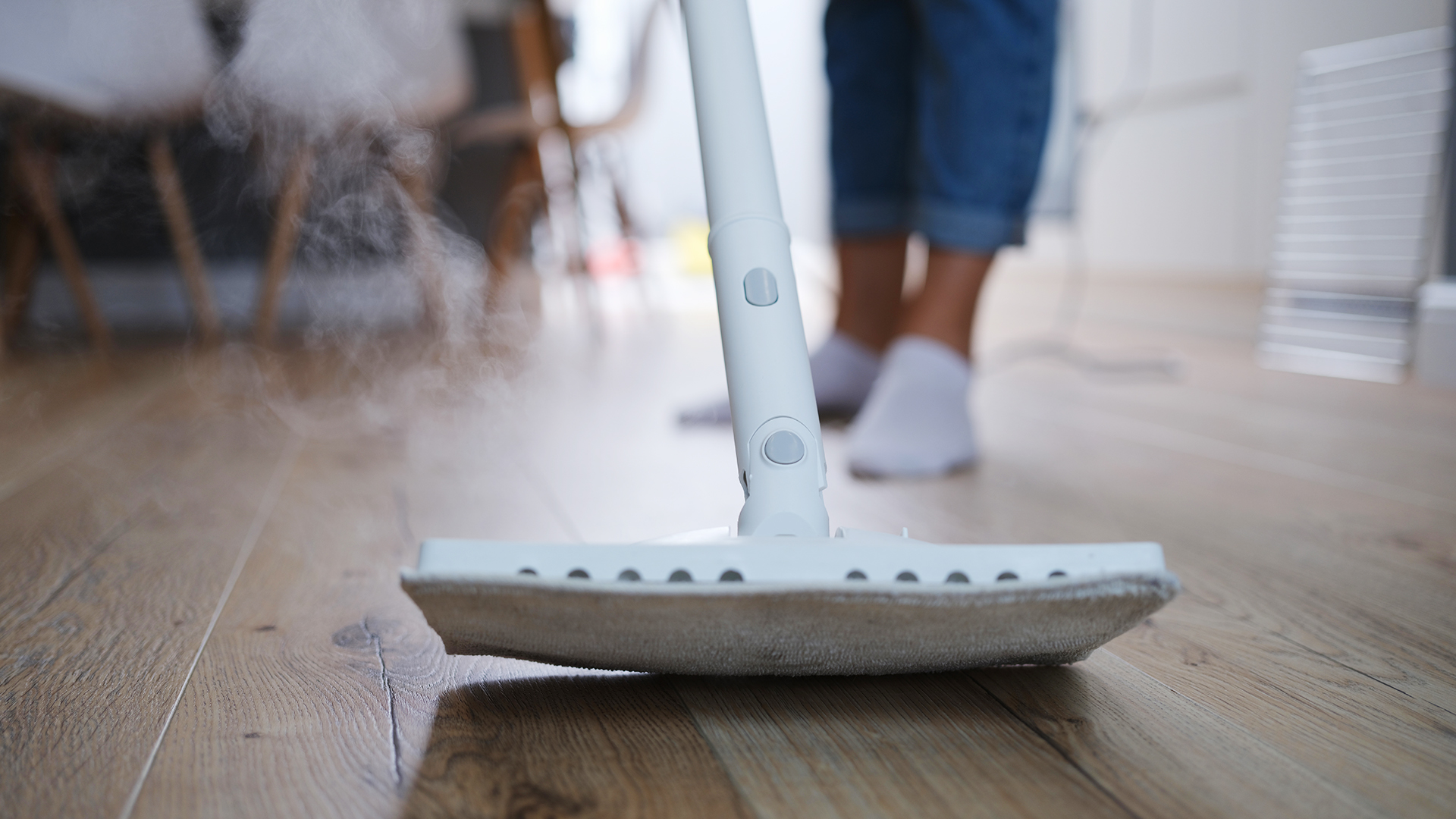Can you use a steam mop on hardwood floors?
Should you try to use a steam mop on hardwood floors, or is it too much of a risk?

Hardwood floors are a timeless choice for indoor flooring but can be a headache when cleaning. There is an advantage to using a steam mop on hardwood floors; the steam is so hot that it sanitizes flooring, with some steam mops claiming to be up to 99.9% effective at eliminating germs. This makes for a quick and sanitary clean.
By comparison, traditional damp mopping can take a long time to cover the surface area of a whole kitchen, leaving behind streaks of whichever chemicals you’re using in your cleaning solution.
Can you use a steam mop on hardwood floors? Well, yes and no. Opinion is very divided, even among the professional cleaning community. It depends on whether the floor is sealed and how willing you are to risk water damage.
Not all of the best steam mops are created equal, and how efficiently they deliver steam without leaking is crucial to whether you feel comfortable using them on your wooden flooring.
How often you should clean hardwood floors
If you have hardwood floors, you’ll already know they are a magnet for dust bunnies. You’ll want to sweep or hoover more or less every day to keep them totally dust—and debris–free, but mopping can be done less frequently.
In high-traffic areas, such as kitchens, bathrooms, or living areas, once a week should be fine. To avoid staining the wood, repeat cleaning as often as necessary, especially if the area becomes soiled.
Risks of using a steam mop on hardwood floors
Kaylie Ross of Peachy Clean Carlisle says, “I always ask my customers about what they want me to use with wood floors, such as herringbone flooring. Sometimes, using a steam mop on wood floors can lead to water penetrating the wood and rising grain wood so that I would be very careful.”
Many professionals do not recommend using a steam mop on hardwood flooring because of the risk of damage it poses if the moisture penetrates beneath the surface of the wood. This can lead to the following issues with your wooden flooring, often progressing from one stage to the next:
Sign up to receive the latest news, reviews, buying guides and deals direct to your inbox
• Warping out of its original shape
• Expanding and ultimately not fitting together
• Creating raised edges on the wood, which could become trip hazards
• Discoloration and patchy areas of hyperpigmentation
• The grain rising in the wood
• Splitting
• Rotting
Understandably, this can put some people off even attempting to use a steam mop on hardwood floors. When used on unsealed wood, the water permeates the wood, causing the issues discussed above. It’s a big enough issue that using a steam mop on hardwood floors often invalidates its insurance if you have it covered under a specific policy.
To try to understand better if we should be using a steam mop on hardwood floors, we spoke to professional cleaner Kaylie Ross of Peachy Clean Carlisle. As the owner of a skilled domestic cleaning business, she gives us her take on how she handles the topic with clients.
Ultimately, Kaylie acknowledges that the customer will know better whether the floors have been sealed and whether or not they are willing to take the risk with their own flooring. She advises caution when cleaning with a steam mop on hardwood floors, only ever using it on the lowest setting. The appliance has to limit the amount of water making contact with the wood and potentially waterlogging it.
Steam mops ‘designed’ for hardwood floors
Expert Kaylie Ross uses a steam mop because it has many benefits over traditional mopping. She tells us, “Steam mopping is great for quickly eliminating dirt and germs from floors without using chemicals. Some steam mops can clean and sanitize up to 99.9%. These mops can be used on most floors in a low setting. It leaves floors streak-free with no chemical residue left on floors.”
At this point, you might be wondering whether using a steam mop on hardwood floors at all is possible and if it’s worth the risks. Steam mopping does have some serious benefits that are worth considering, such as being considered an environmentally friendly option due to the high heat of the steam acting as a disinfectant instead of harsh chemicals.
There are specific steam mops that claim to be designed for use on sealed hardwood floors. Sealing essentially means that the wood itself has been coated in a sealant such as polyurethane or varnish, which protects the natural fiber of the wood and creates a barrier against any moisture (wax and oil aren’t effective waterproofing sealants against a steam mop). This is what makes it, in the view of some, suitable for use with a steam mop.
However, it’s worth mentioning that no sealant lasts forever. Patches may erode, especially with frequent steam cleaning, leaving flooring vulnerable to moisture. Steam mops engineered specifically for hardwood floors are designed to take advantage of ‘dry steam’ and operate on a gentle, low water setting at very high heat. This ‘dry steam’ cleans at extremely high temperatures, sanitizing with heat and leaving little water residue behind due to evaporation.
Reviews
Whirlpool 24" Stainless Steel AI Dishwasher Review
Napoleon TravelQ PRO285 Portable Gas Grill review
Dreame L40 Ultra Robot Vacuum Cleaner and Mop review: almost hands-free cleaning
GE Profile Smart Mixer with Auto Sense review: a powerful, thorough mixer
Echo eForce DPB-2500 review: a leaf blower as a snow removal tool?
DPAS-2100 + Pro Paddle Attachment review: a new way to remove snow this winter?
Midea MAD53109APK 5.5QT Air Fryer review: a small, simple, and highly effective option
Eureka J15 Pro Ultra Robot Vacuum review: hands-free cleaning for busy families
If you try it yourself, remember to keep your steam mop moving, as forcing the steam down into one area for too long risks over-wetting it. As the steam is pressurized, it will permeate unprotected wood much more easily than a wet mop. This is why it may also erode the finish of your wood, dulling it.
Can you use a steam mop on engineered wood flooring?
In case you’re wondering, engineered wood flooring is still real wood. The wood is just structured into thinner layers, instead of being made from pure hardwood. Typically, a strong baseboard is made from a cheaper but stronger material such as ply. The top layer is between 2mm and 6mm thick and is pure hardwood, almost always coated in lacquer or varnish for extra strength. This method allows less expensive hardwood to be used, making it a more affordable option.

The top layer of engineered wood flooring is the same as using a steam mop on hardwood floors, so the same advice stands. If it's sealed, you can attempt to steam mop in a gentle setting. However, something to be mindful of is that engineered wood is usually much thinner than traditional hardwood planks. This means that if water does permeate it, it will take less time to warp it out of shape, so use caution.
Can you use a steam mop on vinyl wood flooring?
Vinyl wood flooring is a popular type that mimics the look of wood grain but is actually made up of engineered planks made from hardened PVC. As PVC is plastic, it's not advisable to use a steam mop due to the risk of the high temperatures of the steam warping and damaging the surface of the flooring.
Vinyl wood flooring often relies on closely fitting the joints of the planks together, so any warping from heat is also likely to prevent them from fitting together properly. Another safety issue is that glue is often used underneath vinyl wood flooring to stabilize it. The pressurized steam may breach the joints of the flooring, reaching the glue and melting it, further destabilizing the flooring.
Tanisha started her career in commercial retail buying for one of Amazon UK’s Top 10 revenue grossing online homeware retailers. Years spent obsessing over homeware products made it an easy career switch to writing about them. Her freelance career has seen her craft customer-focused web content for brands big and small, as well as writing articles in the health, lifestyle, home and retail sectors.

